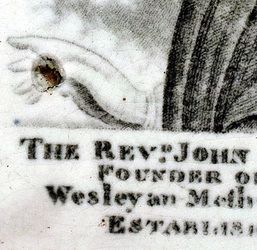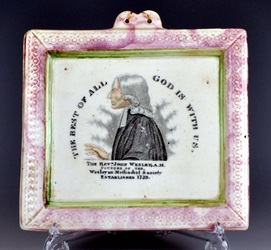|
At last, my image request from the Willet Collection has arrived. The image is credited to The Royal Pavilion and Museums, Brighton & Hove image store. It has been a while, but you may remember in my May 6th post I wrote about this Wesley transfer. It appears on two plates with Sheriff Hill Pottery impressed marks. But the plaque form below is more usually associated with Robert Maling. However, this plaque isn't marked. So firstly, is it the same transfer? Top below is the marked Sheriff Hill plate (click on the images to enlarge). Second is a plaque I've attributed to Sheriff Hill. Third is the Maling-type plaque. The first obvious difference is the quality of the imprint. In fact, the Maling-type plaque is so faint, I've had to turn up the contrast on the details in Photoshop to help comparison. The items above do share transfers from the same copper plate. We know this because the have the same flaws (see right details): the top right of the letter 'N' in 'JOHN' is infilled; and the letter 'M', in Methodist has a heavy left foot. Given the faintness of the Maling-type plaque's imprint, it seems fair to assume it was produced later. So based on this small sample, a plausible explanation would be that Sheriff Hill made plates and small plaques from 1830–1845. After that, their transfer plates found their way to Maling. Below I've compared a late Sheriff Hill-attributed plaque with the Maling-type plaque. This time with no adjustment of contrast. If you click on the centre detail of the second plaque, you'll see that despite its faintness, it appears to have been re-engraved. The lines on Wesley's wig have been picked out in rows of small dots, that don't appear on the earlier imprints. It seems safe to assume, based on both the form of the plaque and the quality of the imprint, that the Maling-attributed plaque was made later. Based on similarity of decoration to the plaque below left, the Sheriff Hill plaque was likely made in the 1840s. Interestingly, when I looked at it this morning, I noticed a trace of pink transfer on the back (right detail). This is similar to, though not an identical match for, the pink sheet pattern that appears on the marked Sheriff Hill plate in my last blog post. It's by no means conclusive, but nevertheless, another thumbs up for the Sheriff Hill attribution. In case you thought everthing was neatly sewn up, there's still the small matter of the plaque found in an old Railton's catalogue (below left). It has the Robert Maling impressed mark, which is thought to have been used 1830–40. However, the transfer also appears on Sheriff Hill-attributed plaques from between those dates (see below right). The copper transfer plate couldn't be in two places at once. Perhaps the Robert Maling mark was used for longer than normally credited? Steven Moore suggests 1830s or 1840s. So my best guess is that the transfer plates moved to Maling around 1845, when the Jackson and Patterson partnership ended at Sheriff Hill. And that the Robert Maling-marked plaque was made shortly afterwards. According to R C Bell (not always accurate) Robert Maling retired in 1853. If you have a marked Robert Maling plaque, or even an unmarked one with a 'Sheriff Hill' verse, please don't be shy. Get in touch! N.B. Robert Maling marks can be very difficult to read (see below).
0 Comments
Leave a Reply. |
AuthorStephen Smith lives in London, and is always happy to hear from other collectors. If you have an interesting collection of plaques, and are based in the UK, he will photograph them for you. Free advice given regarding selling and dispersal of a collection, or to those wishing to start one. Just get in touch... Archives
February 2022
AcknowledgementsThis website is indebted to collectors, dealers and enthusiasts who have shared their knowledge or photos. In particular: Ian Holmes, Stephen Duckworth, Dick Henrywood, Norman Lowe, Keith Lovell, Donald H Ryan, Harold Crowder, Jack and Joyce Cockerill, Myrna Schkolne, Elinor Penna, Ian Sharp, Shauna Gregg at the Sunderland Museum, Keith Bell, Martyn Edgell, and Liz Denton.
|






















